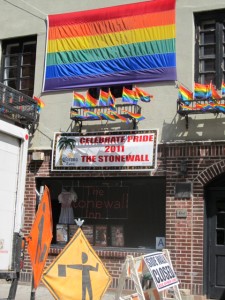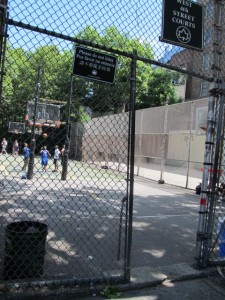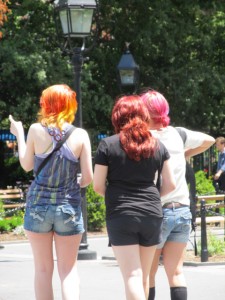June 29, 2011
Wednesday
. . . when Jude had allowed himself to imagine [New York], he’d pictured it the way he’d pictured far away capitals like London or Berlin — wide gray sidewalks choked with adults in long coats, with leather briefcases and good haircuts, no children in sight.
        — from the novel Ten Thousand Saints
            Eleanor Henderson, b. (c) 1979
            American fiction writer
Ten Thousand Saints is the debut novel of Eleanor Henderson, a writer who had just finished her MFA at the University of Virginia in the summer of 2005 when she and I were assigned to the same workshop at the Bread Loaf Writers’ Conference. Eleanor’s story was up for discussion right after mine, so it fell to me to introduce her. “I greet you at the beginning of a great career,” I said to her, so impressed, so dazzled was I by her work.
I was excited to hear this novel was coming out, ecstatic when I bought it. As an object, it’s beautiful — nearly 400 pages, deckled fore edge, creamy paper that is a sensual delight to touch. I began reading it on June 12. The words inside, the unfolding story, were just as compelling. I hoped to finish it before I left for New York, because I thought it too heavy to haul along. But I read slowly, 30 pages an hour, and usually only in the morning, with my coffee. It quickly became apparent I wasn’t going to finish it in time. As it happened, the action takes place in a medium-sized college town in Vermont and also in New York City. One is a milieu I am fairly familiar with. The other is, to this suburban hockey mom anyway, the somewhat exotic and unknown locale I was headed for. I decided to take Ten Thousand Saints along, despite its heft.
Jude Keffy-Horne, the teenage central character in the book, was born in New York City but had grown up with his adoptive parents in Vermont. His parents are divorced, and after suffering a tragedy involving the death of his best friend, he goes to New York City to stay with his father and spend some time with the best friend’s brother. Much of the New York action takes place in the dodgy area around Tompkins Square and St. Mark’s Place in the East Village.
Today I undertook one of the treks outlined in New York Walks, a guidebook that presents 14 routes to explore Manhattan on foot. “A Leafy Bohemia,” which begins at Sheridan Square and ends at the Washington Square Arch, takes the sight-seer to the more tourist-friendly West Village.
 Much of the area was hung with rainbow banners today. Sunday had been the annual Pride Festival parade. By happenstance, this celebration of gay culture coincided this year with the passage by the New York legislature of a law which allows same-sex couples to marry, legally and officially. Construction equipment was set up in front of the Stonewall Inn, the gay bar on Christopher Street where riots erupted in 1969 after a police raid of the establishment, so it was hard to get a good picture of it.
Much of the area was hung with rainbow banners today. Sunday had been the annual Pride Festival parade. By happenstance, this celebration of gay culture coincided this year with the passage by the New York legislature of a law which allows same-sex couples to marry, legally and officially. Construction equipment was set up in front of the Stonewall Inn, the gay bar on Christopher Street where riots erupted in 1969 after a police raid of the establishment, so it was hard to get a good picture of it.
I followed the tour as outlined, spending some time with George Segal’s life-size sculptures representing two gay couples. (I said “Excuse me” to one of the standing figures when I bumped into it, even though the bronze sculpture painted white is clearly not a real person.) As suggested, I entered McNulty’s at 109 Christopher Street “just to inhale the aroma from the apothecary jars brimming with Irish Cream coffee and lemon tea.” According to McNulty’s website, “A visit to our store is like a journey into another age.” The aroma was indeed wonderful, but it wasn’t much different from my favorite bulk coffee and tea shop at home, Kauffman’s Coffee Tea & Spice. And at Kauffman’s, the proprietor smiles and calls me by name, even if I haven’t been there for a year. I was completely ignored at McNulty’s. I didn’t buy anything.
The neighborhoods I walked through were pretty quiet. It’s mostly residential, and this was an ordinary Wednesday. I stopped in front of 75½ Bedford Street, the narrow house where Edna St. Vincent Millay lived while she was writing The Harp Weaver and other Poems, the book that was awarded the Pulitzer Prize in 1923. The house is 9½ feet wide. It was sold in May for a little more than 2 million dollars. The stroll through these narrow streets was “leafy,” as promised, but not so noticeably “bohemian,” just rows of pretty houses, some with bars on the lower windows.
 At the corner of West Fourth Street and Sixth Avenue I suddenly knew where I was. The West 4th Street Courts and Golden Swan Park are at the corner where I come up out of the subway the several times I have journeyed on a Sunday morning to attend services at Judson Memorial Church. (See “Who Knows How My Love Grows?” for an account of my first visit.) My previous visits were in the winter, so there hadn’t been any basketball action going on in The Cage. There was plenty today, and as I continued north, the mood and the energy of my walk began to change.
At the corner of West Fourth Street and Sixth Avenue I suddenly knew where I was. The West 4th Street Courts and Golden Swan Park are at the corner where I come up out of the subway the several times I have journeyed on a Sunday morning to attend services at Judson Memorial Church. (See “Who Knows How My Love Grows?” for an account of my first visit.) My previous visits were in the winter, so there hadn’t been any basketball action going on in The Cage. There was plenty today, and as I continued north, the mood and the energy of my walk began to change.
A film crew was set up near an entrance to an NYU law school building. Who they were and what they were filming — exterior shots for a tv episode? an ad? — remained unclear. Washington Square Park was to my left, obscured by construction equipment and hazard fences, the same ones likely that had been in place the last time I’d come to Judson Church, eighteen months ago.
I entered the park, and found myself no longer in a leafy Bohemia, but in an open marketplace pulsing with life, Times Square without the neon (and a little less crowded).Here were the people that Jude Keffy-Horne had envisioned, not many long coats because of the weather, but lots of leather briefcases, women in hose and heels, people working on their laptops, people reading hardbound books. One woman appeared to be talking to herself, but as I drew near (the restroom building was behind her) I could see that she was talking earnestly into the hands-free cell phone clipped to her ear. She was a law student, evidently, and it seemed things had not gone well for her this morning.
I bought a bottle of water from a cart vendor and sat down on the shady side of the wide pool with a spouting fountain in the middle where both children and adults were splashing. And as I sat there, I became aware that those sitting near me were not law students nor business people, but street people, some of whom perhaps live in the park, people in odd costumes (one woman had on a winter hat and a long-sleeved sweater) with bundles and black trash bags beside the spots that they occupied. Some of them were, like the well-dressed law student I had passed when I arrived, talking to themselves. But they weren’t using a Bluetooth headset.
These are the people Jude Keffy-Horne finds himself among when he comes to New York and takes up with his best friend’s brother, a freelance tattoo artist and musician who is “straight edge” (that is, he has eschewed drugs, alcohol, tobacco, and meat), but who has many acquaintances who are not. They are not the people Jude envisioned, in a city he had not imagined very accurately.
I spent about an hour there. I took pictures of monuments, of the great arch. I felt awkward taking pictures of the odd and colorful people. because homelessness and mental illness should not be a spectator sport. I did get one that I thought I could publish, three young women who appeared to be ordinary people, tourists maybe, enjoying themselves. I photographed them from behind, because I had not asked their permission. I think, though, that a picture of their faces would be less interesting.
